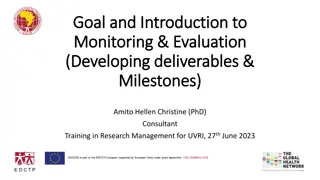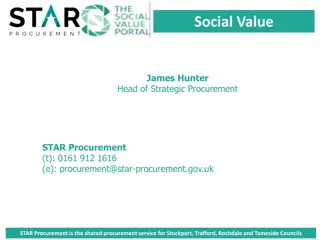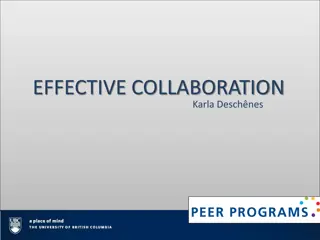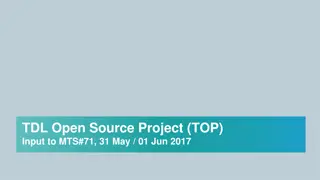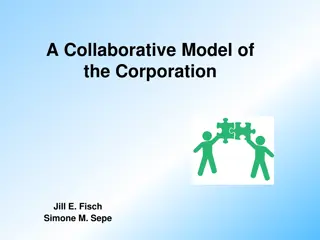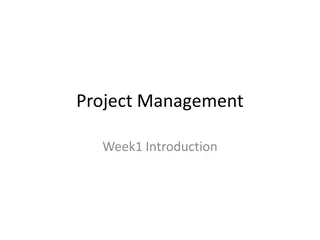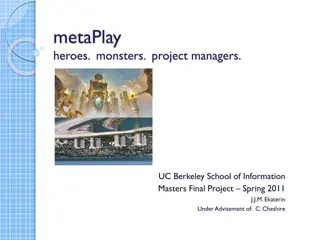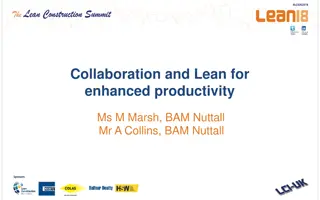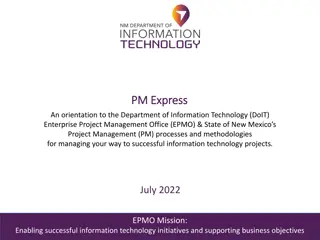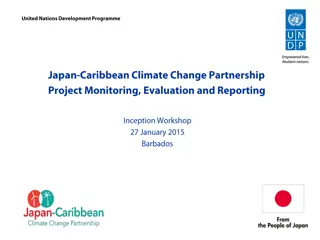Value of Collaboration in Project Management
Collaboration in project management is essential for successful outcomes. Foresight and insight play crucial roles, highlighting the significance of planning, scheduling, cost management, and integration challenges. Opportunities for integration and collaboration through various tools and systems further enhance project execution and decision-making processes.
Download Presentation

Please find below an Image/Link to download the presentation.
The content on the website is provided AS IS for your information and personal use only. It may not be sold, licensed, or shared on other websites without obtaining consent from the author.If you encounter any issues during the download, it is possible that the publisher has removed the file from their server.
You are allowed to download the files provided on this website for personal or commercial use, subject to the condition that they are used lawfully. All files are the property of their respective owners.
The content on the website is provided AS IS for your information and personal use only. It may not be sold, licensed, or shared on other websites without obtaining consent from the author.
E N D
Presentation Transcript
Foresight and Insight: The Value of Collaboration in Project Management Nicholas Pisano President and CEO Safran North America, LLC NDIA PMSC Meeting 12 May 2010
Planning and Scheduling is the Backbone for Collaboration Plans and Schedules assist in identifying all constraints of a project (time, cost, scope, quality, benefits, technical, risk, etc.) as well as the methodology used by other disciplines Scheduling tools generally accommodate the ability to interface with other systems (through custom fields, outline codes, activity ID s) Communicate all contractual components Plans and Schedules drive management decisions in all capacities Provide repeatable processes to standardize across portfolios They re a basis for collaboration across project events including feedback loop management processes
Cost and Schedule from the Ground Up Single data source provides greater traceability and data fidelity Tied to the actual work Resource and financial constraints are more easily identified Integration at the lowest level provides greater ease of use and less effort to develop and maintain the data
Integration Challenges Stove piped, best of breed applications Promotes disconnected islands of data Lack of business process integration Processes are inefficient, plagued by human interactions and requirements are to integrate bare minimum Heavy reliance on PowerPoint for reporting and Excel for reconciliation Information is cleansed from baseline systems as it gets passed up and shared Significant investment already made in existing applications, customization and legacy systems Resistance to change within executing programs Technologies available in the past made this difficult, time consuming and costly Data transfers files, Data Warehousing, OLAP Cubes, API/Web Service Integration Glorified PowerPoint presentations on the Web
Opportunities for Integration and Collaboration Scheduling Tools Earned Value Engines Job Card & Detail Milestone Applications Cost Estimating Tools Quantitative and Qualitative Risk Applications ERP Systems Financial & Timesheet Applications Document Management & Requirements Procurement Systems Analytical and Reporting Tools
Integration Points for Across Applications are Relational
Aggregate Data as Appropriate According to Role Regardless of the Underlying Application Executive Management Functional Management Customers Oversight Agencies Consumers Program Managers CAM s & Engineering Leads Sub Contractors Product, Test & Other Support Centers Performers Financial & EVM Analyst Master Planner & Schedulers Performance and Risk Managers Program Controls Caretakers
Appropriate level of integration and aggregation varies based on vertical roles Concerns: Funding, Profitability, Expenditures Visibility: Vertically at high level Concerns: Metrics, inconsistencies, analysis Visibility: Vertically at detail level Concerns: On schedule and on budget Visibility: Vertically/Horizontally at mid level Concerns: Health, progress, forecast Visibility: Horizontally at detail level
Data Integration and Collaboration Across Disparate Systems EV Schedule Resource Risk
Data Integration and Collaboration Across Disparate Systems Schedule Jobs Document PO s
Visualization Elements and Controls Needed for PM Data Data Grid Color Coding, filtering, sorting, grouping Gantt Control Visualize time scaled data Charts Line, pie, bar, stack, etc. Data Modeling Sandbox for pivoting related datasets Other Completion report, tabular reports, area maps
Visual Elements in Grid and Gantt Progress bar is green if 100% Barisred if > 10 000 hours Show expected Range if Behind Schedule Blue box indicates child-range (min - max). Hatch=Outside parent range! The more negative the number, the more attention it should get: Score = Hours * Delta% / 100 This bar is more yellow , indicating it has more hours. Transparency controlled by hours compare with topmost bar!
Including Government Reports such as the CPR, other EVM artifacts and deliverables
Collaboration provides Foresight Dashboards and Stop-lights are old hat and easy to game Intelligence is needed in extending our systems in lieu of collecting a row of metrics Apply best practice parametrics to normalize and quantify measurements Make the underlying data actionable! Stop reinventing the wheel tools exist to preclude labor intensive custom software development: COTS/NDI model now applies to cross-application, cross-discipline integration without data transfer
Layering intelligence to take out the grunt work of Project Management The ability to visualize data makes it easier for us to conceptualize trends and to transform raw data into intelligence Modeling allows us to filter out false leads With appropriate source data and business rules we can be more precise and rational in our business decisions Moves us away from glorified PowerPoint This approach allows for integration and value- added intelligence of subcontractor data
Applying Parametric Analysis to Source Data Technical performance measures Qualitative measures Assessments of risk Assessing proportionality of impact Predictive methodologies for complex adaptive systems A complete real time project control ecosystem
Evolution of Integrated Digital Environment Hard-coded development Rudimentary data cut and paste (with scripting) Rudimentary data transfer (PA, X12) Data mining, cubes, mapping and interfacing Advanced data transfer (XML) Virtual data repository (Open OLE-DB)
Where to find more information on these concepts: www.safranna.com Safran User s Group LinkedIn E-mail: npisano@safranna.com 2010 Safran North America LLC. All Rights Reserved
Evening event on the Terrace tonight at 6pm Tapas and Drinks




